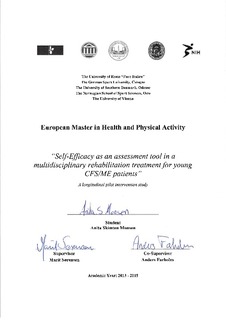| dc.description.abstract | Myalgic encephalomyelits (ME), also known as Chronic Fatigue Syndrome
(CFS) is characterized by unexplained, long-lasting, disabling fatigue resulting in severe
impairment in daily functioning. Capability to resume a normal life-style including social
activities, schooling, sports and other activities, are essential for young CFS/ME patients for
physical-and psychological development. The aim of the present thesis is to examine selfefficacy
for being physically active as an assessment tool in treatments for young CFS/ME
patients, and if self-efficacy can influence participation in PA. This research is the first to
include both objectively measured PA and self-efficacy in a longitudinal design for young
CFS/ME patients. Method: Data was collected from a pilot study conducted at a
rehabilitation institution in Norway. Self-efficacy scale (SES) and PA was measured at 3time
points (TPs); before (TP1), during (TP2), and 12 weeks after receiving a 4-week
multidisciplinary treatment (TP3). The treatment included graded activity treatment (GAT),
and development of individual activity plans as a coping strategy to resume a balance between
activity, rest and a normal sleep pattern. Results: 24 participants (age 17, 83 SD ± 2) were
included for analyses. Results indicated increased self-efficacy for being physically active
during the treatment (nearly significant, p=0.06), but were not maintained 12 weeks after.
Neither change in upright activity nor MVPA between the TPs were significant in the mean
time of the total sample. However, participants who increased upright activity during the
treatment had a decrease 12 weeks after (p<0.05), while participants who decreased upright
activity during treatment maintained their activity 12 weeks after (p>0.05). There were a
negative relationship between PA and SES during the treatment. This can be explained by
mastery in coping strategies involving reduction in activity to avoid symptoms. Conclusion:
Feasibility of design and method are considered as good, giving opportunity to investigate
changes self-efficacy and PA over time in a safe environment. Because of low statistical
power this results should be used with caution. However, assessment of self-efficacy in
treatment for CFS/ME is informative and important to understand PA behavior, but further
investigation is needed. | nb_NO |
